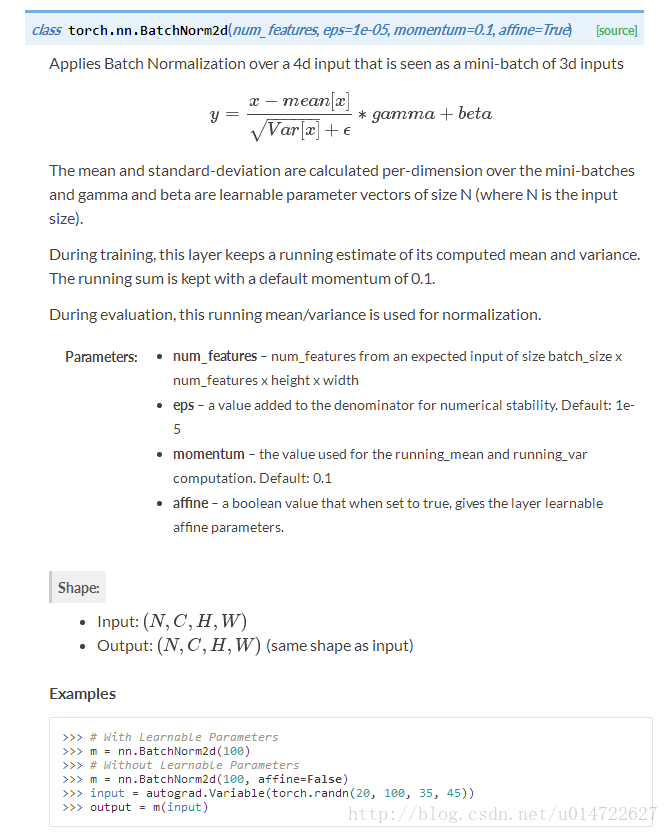Pytorch官方文档:

测试代码:
转自:https://blog.csdn.net/tmk_01/article/details/80679549
import torch
import torch.nn as nn
m = nn.BatchNorm2d(2,affine=True) #weight(gamma)和bias(beta)将被使用
input = torch.randn(1,2,3,4)
output = m(input)
print("输入图片:")
print(input)
print("归一化权重(公式中的gamma):")
print(m.weight)
print("归一化偏置(公式中的beta):")
print(m.bias)
print("归一化的输出:")
print(output)
print("输出的尺度:")
print(output.size())
# i = torch.randn(1,1,2)
print("输入的第一个维度:")
print(input[0][0])
firstDimenMean = torch.Tensor.mean(input[0][0])
firstDimenVar= torch.Tensor.var(input[0][0],False) #Bessel's Correction贝塞尔校正不会被使用
print(m.eps)
print("输入的第一个维度平均值:")
print(firstDimenMean)
print("输入的第一个维度方差:")
print(firstDimenVar)
bacthnormone =
((input[0][0][0][0] - firstDimenMean)/(torch.pow(firstDimenVar+m.eps,0.5) ))
* m.weight[0] + m.bias[0]
print(bacthnormone)
代码运行结果:
输入图片:
tensor([[[[-1.1622, -0.9170, -0.6798, -0.0270],
[ 0.2687, -1.6046, -0.2142, -0.3561],
[ 0.2908, -0.1012, 1.3594, 1.1316]],
[[ 0.4689, 1.4049, 1.2324, -1.3721],
[-0.1498, -0.3207, 0.5072, -1.2563],
[ 1.5934, -0.8010, 0.1270, 0.5993]]]])
归一化权重(公式中的gamma):
Parameter containing:
tensor([0.8681, 0.7207], requires_grad=True)
归一化偏置(公式中的beta):
Parameter containing:
tensor([0., 0.], requires_grad=True)
归一化的输出:
tensor([[[[-1.0344, -0.7794, -0.5326, 0.1463],
[ 0.4538, -1.4945, -0.0484, -0.1960],
[ 0.4767, 0.0691, 1.5881, 1.3512]],
[[ 0.2279, 0.9400, 0.8088, -1.1729],
[-0.2429, -0.3729, 0.2570, -1.0848],
[ 1.0834, -0.7384, -0.0323, 0.3271]]]],
grad_fn=<ThnnBatchNormBackward>)
输出的尺度:
torch.Size([1, 2, 3, 4])
输入的第一个维度:
tensor([[-1.1622, -0.9170, -0.6798, -0.0270],
[ 0.2687, -1.6046, -0.2142, -0.3561],
[ 0.2908, -0.1012, 1.3594, 1.1316]])
1e-05
输入的第一个维度平均值:
tensor(-0.1676)
输入的第一个维度方差:
tensor(0.6967)
tensor(-1.0344, grad_fn=<ThAddBackward>)
BatchNorm深度理解可参考:
https://zhuanlan.zhihu.com/p/30922689
4.Normalizing activations in a network
5.Fitting Batch Norm into a neural network
6.Why does Batch Norm work?
7. Batch Norm at test time